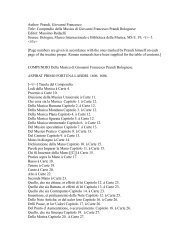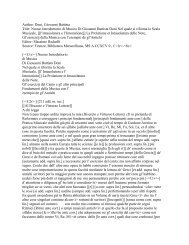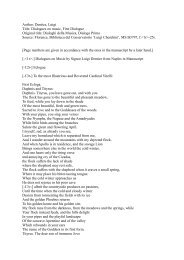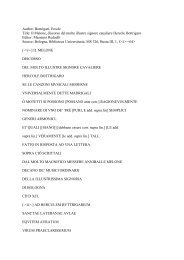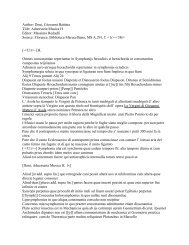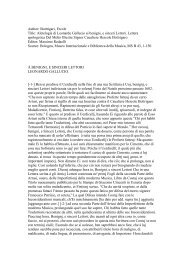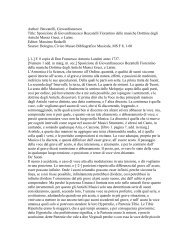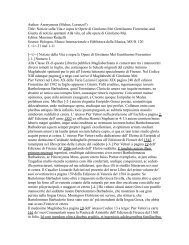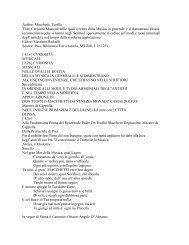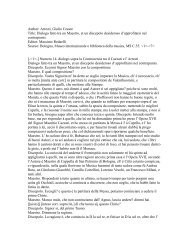Author: Doni, Giovanni Battista - manuscripts of italian music theory ...
Author: Doni, Giovanni Battista - manuscripts of italian music theory ...
Author: Doni, Giovanni Battista - manuscripts of italian music theory ...
You also want an ePaper? Increase the reach of your titles
YUMPU automatically turns print PDFs into web optimized ePapers that Google loves.
did not perhaps to be criticised because he said that the larger tone is typical <strong>of</strong> the<br />
Diatonic, if he believed that tone to be the one contained within the tetrachrds, rather<br />
than one <strong>of</strong> the Disjunction, rather than the smaller Tone, as he maintains, because the<br />
smaller Tone is found also in the Chromatic, at least compounded, namely moving<br />
from the first to the third note, since it is very clear that its integral parts are the larger<br />
semitone and the smaller one. However, if we modulate the larger Semitone as the<br />
perfect chromatic requires and if we want to have the remaining minor third as a<br />
consonant interval, one will not find the larger Tone, because, if one splits the larger<br />
tone into two Semitones, the third is reduced as much as the smaller semitone is<br />
enlarged, which is by a comma, hence the third stays dissonant. This semitone is<br />
located between<br />
[sqb] et b, which notes are not specifically chromatic. It consists <strong>of</strong> the proportion<br />
138/125 which is almost an equal semitone. Those who criticise too rigorously<br />
someone else’s doctrine fall into this sort <strong>of</strong> errors without noticing.<br />
[--] Reports <strong>of</strong> authors and arguments which prove the above mentioned<br />
statement chapter<br />
However, so that one does may not walk in the dark in such an essential matter, and so<br />
that any one may know the truth <strong>of</strong> the matter from the evidence, I will adduce some<br />
irrefragable authorities and other pieces <strong>of</strong> evidence which shall demonstrate<br />
manifestly that this axiom is absolutely true, namely that the Tone <strong>of</strong> the Disjunction<br />
is shared by all the genera. Aristoxenus says this in the third book: [ean oun dekhthe<br />
to idion tes diazeuxeos me kinoumenon en tais ton genon diaphorais; delon hoti<br />
leipetai en autois tois tou diatessaron meresi ten kinesin einai.], which means: “If it<br />
will be proven that the first disjunctive interval does not move in the difference <strong>of</strong> the<br />
genera, it will be clear that the alteration has to be in the parts themselves <strong>of</strong> the fourth<br />
or tetrachord.” He says a little later: [En ekasto de genei tosauta esti asyntheta pleista<br />
hosa en to diapente par men gar genos etoi en sunaphe melodeitai, e en diazeuxei.<br />
Kathaper emprosthen eiretai, dedektai d'he men syaphe ek ton tou diatessorn meron<br />
mone synkeiemene he de diazeuxis emprosthen tetheisa to idion diastema. Touto<br />
d'estin ho tonos; prostithentos de toutous pros ta tou diatessaron mere to diapente<br />
sumpleritai. hos einai phaneron hoti epeideper ouden ton genon endechetai kata mia<br />
khroan lambanomenon, ek ton pleionon asyntheton syntetheinai ton [[ek]] en to<br />
diapente onton. Delon hoti en ekasto genei tosauta estai ta pleista asyntheta hosa en to<br />
diapente. Tarattein de eiothen enious kai en touto to problemati pos ta pleisa<br />
prostithetai cai dia ti oukh aplos deiknutai outi ek tosouton asyntheton [--]<br />
ekaston ton genon [[esti synkeikenon]] sunesteken hosa estin en to diapente; pros<br />
hous tauta legeto oti ex elattonon asyntheton genon (lege meron] esti synkeimenon<br />
ekaston; ek pleionon oudepote dia tauten de ten aitian touto auto proton apodeiknytai,<br />
hoti ouk endekhetai ek pleionon asyntheton syntethenai ton genon hekaston e osa os<br />
diapente tunkhanousi onta; oti de kai ex elattonon pote suntethestai hekaston auton en<br />
tois epeita dechthesetai.], which means: “However, in each genus there are as many<br />
uncompounded (intervals) at the most as many there are in the Diapente, because<br />
every genus is sung according to the conjunction or according to the disjunction (by b<br />
flat or [sqb] hard) has it was said before. It was also shown that the conjunction is<br />
composed only <strong>of</strong> the parts <strong>of</strong> the diatessaron (namely <strong>of</strong> two or more fourths0 but the<br />
disjunction adds more to it (as this is what that word [emprosthen] means, as it<br />
sometimes does in Attic writers) but, if one adds the Tone to the parts <strong>of</strong> the<br />
Diatessaron, the result is the Diapente. Hence, it is clear that, since no genus can be



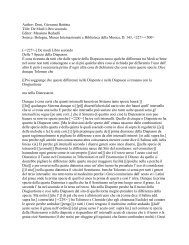
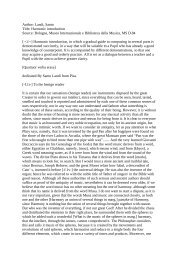
![Doni, Giovanni Battista Title: Trattato Dei Tuoni o [[Harmonie de]]](https://img.yumpu.com/45461005/1/190x245/doni-giovanni-battista-title-trattato-dei-tuoni-o-harmonie-de.jpg?quality=85)
